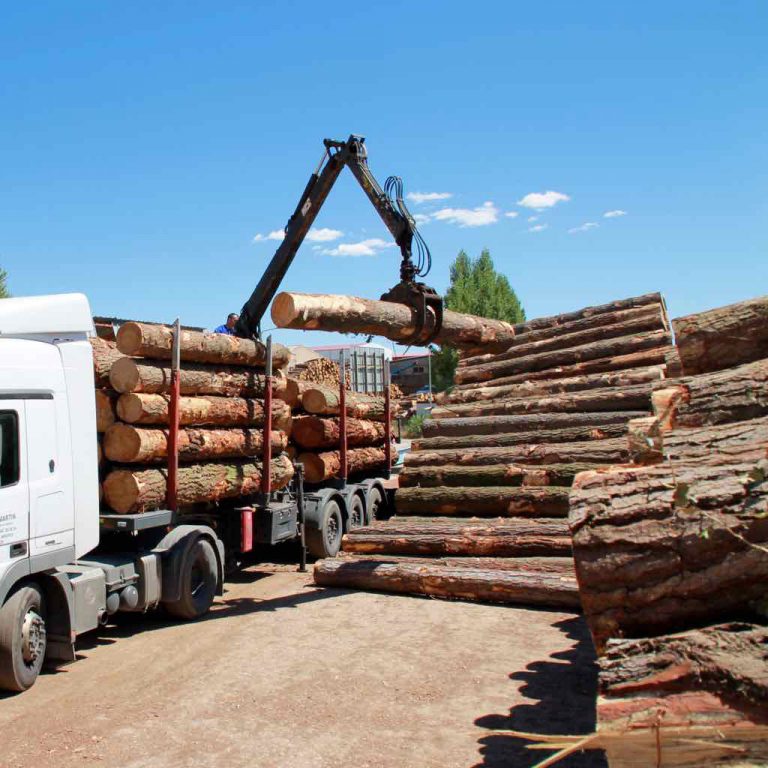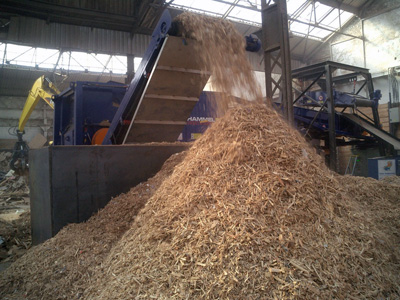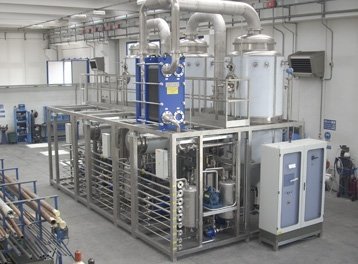Sections
- Wastewater in the wood sector
- Wood industries
- Wastewater produced by wood industries
- Treatment of discharges from the wood industry
- Summary
Wastewater in the wood sector
The wood industry includes activities such as forestry, trade, and the production of primary forest products, as well as finished products like furniture, and secondary products like wood pulp for the paper industry.
Both in the transformation phase and during the production phase, softwood and hardwood can be distinguished.
While softwood is mainly used for fuel and paper pulp production, hardwood is used for making furniture, flooring, etc.
Both types are employed in the construction sector.
After logging, which is typically done with large harvesters, tree trunks are cut in sawmills and subsequently sent to various manufacturers and producers that use wood as raw material: wooden house constructions, solid wood furniture, musical instruments, toys, kitchen utensils, etc.
The wood processing and manufacturing industry comprises four subsectors:
- Sawmilling and processing
- Manufactured wood products
- Wood panel production
- Wood marketing
The sawmilling and processing subsector includes various primary activities such as sawing, peeling, and chipping tree trunks.
The manufactured products subsector sources wood from sawmills and other processing activities to manufacture components, structural systems, and other wood products.
Boards and panels can be made of solid wood, although they are generally made with pressed wood fiber composites: MDF (medium density) and HDF (high density).
In the manufacture of furniture and other solid wood products, adhesives, varnishes, and chemicals that contain a high contaminant load are often used.
Solid components such as cuttings, shavings, fibers, or sawdust can be used as by-products for the production of particle boards, or as fuels and construction materials.
During production and washing processes, liquid effluents are generated that require efficient treatment before being discharged or reused.
Vacuum evaporators are an excellent technology for reducing the volume of these effluents, minimizing both their environmental and economic impact.

Manufacturing of wood panels and furniture
Furniture manufacturing is a complex process that involves several steps. The industrial processes necessary for furniture manufacturing are as follows:
- Design
- Material selection
- Cutting
- Assembly
- Finishing
- Packaging and shipping
The main raw materials are obtained from species such as beech, maple, cherry or pine, oak, chestnut, ash, walnut, or lime.
In these sectors, solid wood and panels made from wood-derived materials (fibers, particles, and plywood) are used to produce the final products.
For solid wood, processes range from marking, cross-cutting, and sawing to bending, turning, carving, sanding, and calibrating, while for derived panels, notable processes include cutting and sizing, edge banding, and veneering.
Both varieties also share processes such as drilling and mortising, sanding and/or calibrating, finishing, and finally assembly.
In the finishing process, products that beautify and protect the surface of the wood pieces can be used, in addition to providing the final appearance and protection desired based on the intended use of the product:
- Adhesives, which increase the resistance of the final products to temperature and other environmental factors.
- The application of stains and varnishes gives a specific color and shine to the wood, helping to preserve its texture and appearance.
- The most common materials in coatings are plastics, aluminum parts, and even hardware and semi-finished products made from various materials and geometries. Their function is to reinforce the structure of the pieces and beautify the final product.

Manufacturing of wood panels
Wood fiber boards have a homogeneous and fine structure, allowing them to be processed similarly to solid wood. The boards can be veneered, laminated, varnished, or coated.
For their manufacture, the bark of tree trunks is used, which is crushed to obtain the fibers that are bonded together with synthetic resins to produce the boards.
They are mainly distinguished between MDF (medium density fiberboards) and HDF (high density fiberboards).
MDF boards (Medium Density Board) are a composite of wood fibers, primarily used for furniture manufacturing.
This product has been on the rise for years due to its combination of great strength, stability, and quality finishes, with very reasonable costs.
Medium density fiberboard (MDF) is mainly used in the furniture and flooring industries, as well as in interior design.
Other application fields include doors, interior linings in the automotive industry, the construction industry, or semiconductor production.
Wastewater produced by wood industries
The furniture industry produces a high percentage of the wastewater generated in the wood sector.
Some of these wastes, such as sawdust, shavings, scraps of veneer and board, or wood cuttings, are reusable as raw materials for the manufacture of other products, thus extending their useful life.
On the other hand, there are consumables related to the operation and maintenance of the machinery and equipment used by the wood industry:
- Oils
- Containers
- Cleaning products
- Solvents
- Etc.
Meanwhile, the guns and booths used for applying varnishes and stains are cleaned with organic solvents, generating complex waste and liquid effluents.
Finally, there are products used in phases such as gluing, staining, priming, finishing, etc., many of which are classified as hazardous.
Some examples are:
- Adhesives with organic solvents or other hazardous substances used for joining pieces or for rejects
- Coating products, such as paints and varnishes, produce VOC emissions when applied and during equipment cleaning.
- On the other hand, in finishing and machining operations, the so-called wood dust is generated, which is highly hazardous due to the composition of the products used.
- Similarly, during the sanding of varnished pieces, varnish dust is formed.
These wastes must be stored and managed as established by the current legislation in each country.
Treatment of discharges generated in wood manufacturing processes
The treatment of effluents in furniture and wood panel manufacturing is crucial to minimize the environmental impact of this industry.
This is a summary of the most commonly used technologies:
- Physicochemical treatment: This process includes coagulation-flocculation and sedimentation of suspended substances, reducing total suspended solids (TSS) and chemical oxygen demand (COD) of the wastewater.
- Vacuum evaporation: This method is very effective for the MDF board industry. Water is separated from the waste through evaporation, obtaining distilled water that can be reused and a waste concentrate that can be used as biomass to generate energy.
- Bioreactors: Bioreactors can degrade the organic compounds present in the effluents through biological processes, thus reducing the contaminant load.
These methods not only help comply with environmental regulations but can also be economically beneficial by reducing operational and waste management costs.
Moreover, treated water can be reused in the manufacturing process, reducing fresh water consumption and minimizing discharges.
Recycling of waste and wood recovery
Among the wood waste generated in carpentries and furniture factories that can be recovered are the following: chips, sawdust, cuttings, shavings, and scraps of boards.
If they cannot be recovered, they must be collected for management through an authorized manager.
Reusing cleaning solvent
To reuse the solvent used in cleaning tools, it is necessary to install a distillation system capable of separating the solvent from the solid fraction.
To facilitate the operation, special attention must be paid to not contaminating the solvent during use with water, oils, or solids, nor with paint residues.
Distillation can be carried out using atmospheric evaporators or vacuum evaporators, in which case the evaporation temperature decreases, increasing safety.
The distilled solvent can be reused in cleaning operations, thus allowing significant savings in the purchase of this raw material.
The recovery of the product also reduces the amount of solvent discarded, as well as the containers that hold it, thereby contributing to a minimization of waste classified as hazardous.

Zero discharge in MDF board manufacturing
Due to the moisture content of wood trunks, which can range from 1% to 15% when dry, the generated effluents contain remnants of fiber and various chemical components present in the wood.
This is an effluent with a high solid content and a high COD.
Physicochemical processes are very common in this sector, although they are often not sufficient to reduce the COD to acceptable discharge levels.
One solution that some manufacturers have tried is to throw the wastewater into the ovens where the boards are treated so that it evaporates with the high heat, but it has proven to be an inefficient alternative, as it leaves residues and stains on the boards.
Undoubtedly, the most suitable alternative for treating the effluents generated in the MDF board manufacturing process is vacuum evaporation, as it allows the reuse of the two rejects obtained after evaporation (the distilled water and the waste concentrate), resulting in zero discharge.
Indeed, the effluent is introduced into the evaporator, which separates the water from the waste it contains (the fibers and other chemical components of the wood), resulting in distilled water, which instead of being discharged can be sent to boilers to generate steam, and a concentrate of wood fiber and other components that can be sent to the biomass boiler to be mixed with other materials and generate energy.
To complete the resource reuse cycle, it is suggested that all tree waste not used to produce MDF boards, such as bark, branches, leaves, etc., can be burned to produce the energy needed to operate the evaporator, which will practically reduce the energy cost of installing this solution to zero.

Conclusion
The wood industry is one of the oldest and most traditional industries worldwide. Wood has been used for building houses, manufacturing furniture, producing paper, and many other purposes.
However, this industry also has a significant environmental impact due to deforestation and water pollution caused by its wastewater discharges.
A good portion of the solid waste can be separated and recovered through a physicochemical process, but wastewater also contains high organic loads and chemical components that prevent its discharge without proper treatment.
At Condorchem Enviro Solutions, we specialize in the design and installation of vacuum evaporators, a technology that allows for the purification of contaminated water while concentrating various wastes, thus providing a comprehensive solution for wastewater treatment and waste valorization.
Bibliography and inquiries
https://www.interempresas.net/Mobiliario
Wood industry (maderapedia.com)